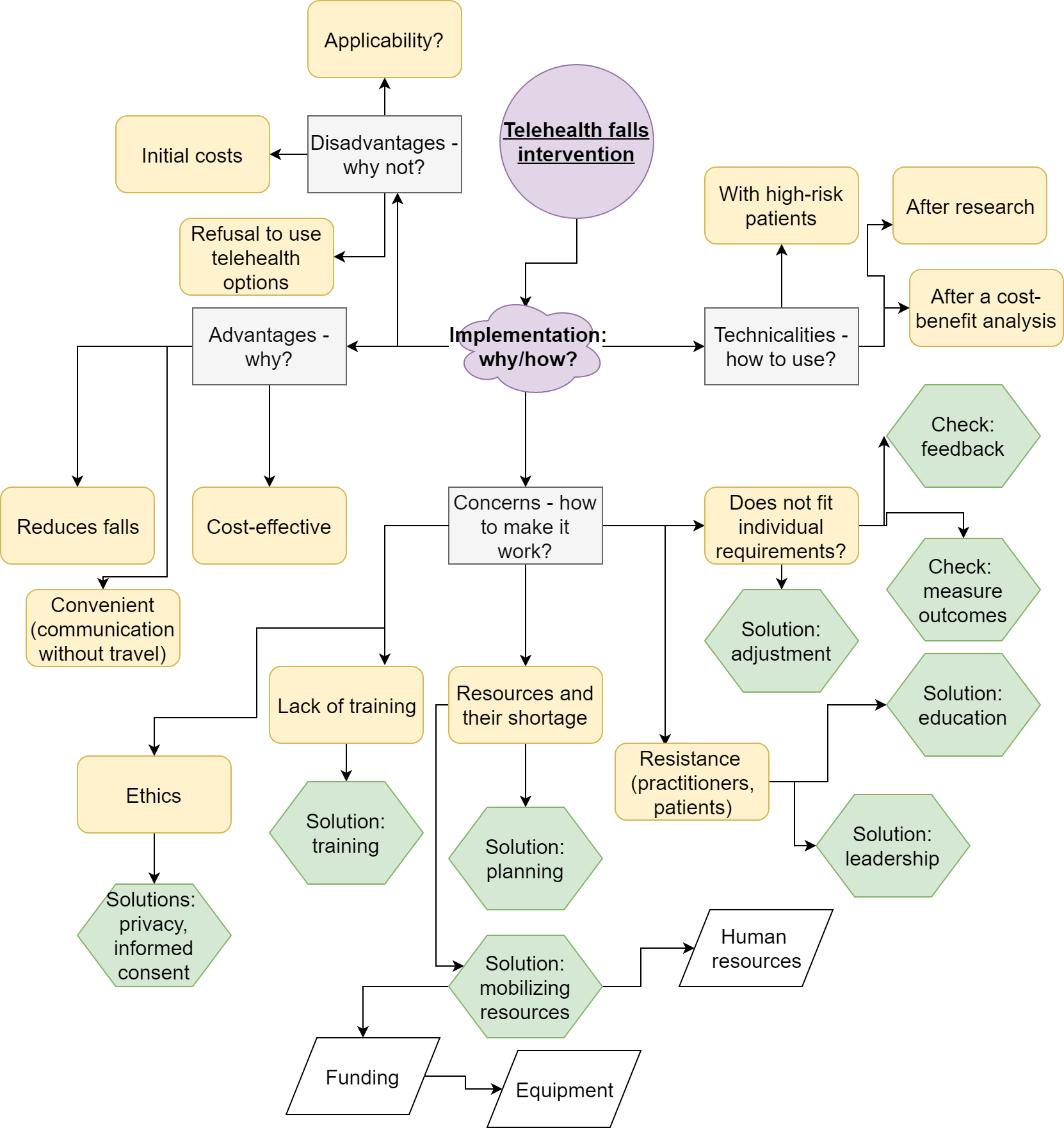Telehealth incorporates a wide range of services that employ telecommunication technology. In this paper, the use of telehealth for fall prevention will be considered by discussing an article by Bernocchi et al. (2019). This source will be reviewed in detail, and a mind map of the technology’s application will be presented (see Appendix). This paper argues that the telehealth program can indeed be used in a healthcare setting, but numerous considerations need to be discussed while implementing it to ensure its effective use.
Précis
The article by Bernocchi et al. (2019) reported the results of a randomized controlled trial that tested a telehealth fall prevention program that incorporated physiotherapist-guided exercise and nurse-led support and follow-ups. The article focused on describing the trial’s objectives, methods, and results; the trial itself involved 283 patients with high fall risks who received either conventional care or the tested program and who were monitored for six months. The article demonstrates that the intervention group experienced significantly fewer falls and were more likely to go longer without falls or have fewer than two falls over six months. This information implies that the described intervention can be an effective solution to fall prevention challenges, which is why it can be considered by healthcare specialists who work with falls-prone patients.
Mind Map Discussion
The main conclusion of the article by Bernocchi et al. (2019) is that the tested program can reduce falls. The present paper will analyze a mind map that follows the key considerations associated with implementing it. The appendix can be consulted to see the map; in it, purple elements represent the main idea and main topic, light blue ones demonstrate subtopics, and yellow and white ones cover additional details.
The implementation of a new technology presupposes multiple questions. Two categories of such questions are incorporated into the map: it intends to determine why and how the implementation could be performed. To find out if the program is required at all, its advantages and disadvantages should be reviewed. As shown by Bernocchi et al. (2019), the studied intervention is effective because it reduces fall rates. Moreover, additional research shows that telehealth is generally cost-effective, which can be partially attributed to the fact that it enables distanced care, reducing time- and travel-related expenses (Lee & Billings, 2016). The disadvantages include initial costs, which are required for equipment and training (Lee & Billings, 2016; Taylor et al., 2015). Also, not all interventions fit all populations (Lee & Billings, 2016), and a certain resistance to telehealth has been found in some patients and providers (Lee & Billings, 2016; Taylor et al., 2015). In other words, telehealth interventions might not fit every case.
Based on this conclusion, it is reasonable to consider the cases in which the intervention should be used; on the map, this question is stated as finding out how to use the intervention. Bernocchi et al. (2019) studied high-risk older populations, which is why the program should be applied to similar patients. Additional research might provide more data on other groups, but for the time being, it is reasonable to study the program and conduct a cost-benefit analysis for it. If it is established that the patients of a particular practice or practitioner need the program, it should be introduced.
Finally, the map asks the question of how to make the new program effective. Telehealth is associated with some ethical problems, especially those connected to private information and informed consent use; they can be handled through relevant policies (Lee & Billings, 2016). Resistance to change from patients and practitioners can be encountered and managed through education and leadership (Lee & Billings, 2016; Taylor et al., 2015). Furthermore, any change is associated with the task of mobilizing and allocating resources through planning; also, human resources may require additional training (Lee & Billings, 2016). Finally, Lee and Billings (2016) state that customization is needed for individual patients, especially those who find it difficult to use telecommunication technologies. Thus, an analysis of the different aspects of fall prevention telehealth programs helps to determine how to implement them in practice most effectively.
Conclusion
Bernocchi et al. (2019) reported a trial of a telehealth program, demonstrating that it was effective in reducing falls. Therefore, the program can be implemented in practice, but the process requires a critical review of the data about the program and telehealth, which can be done using a mind map. The presented map can help to determine if the implementation is reasonable based on the program’s advantages and disadvantages. Also, it can assist in finding out how to apply for the program and how to make it effective. A review of several key concerns, including ethics, change management, and customization, is incorporated into the map as well.
References
Bernocchi, P., Giordano, A., Pintavalle, G., Galli, T., Ballini Spoglia, E., Baratti, D., & Scalvini, S. (2019). Feasibility and clinical efficacy of a multidisciplinary home-telehealth program to prevent falls in older adults: A randomized controlled trial. Journal of the American Medical Directors Association, 20(3), 340-346. Web.
Lee, A., & Billings, M. (2016). Telehealth implementation in a skilled nursing facility: Case report for physical therapist practice in Washington. Physical Therapy, 96(2), 252-259. Web.
Taylor, J., Coates, E., Brewster, L., Mountain, G., Wessels, B., & Hawley, M. (2015). Examining the use of telehealth in community nursing: Identifying the factors affecting frontline staff acceptance and telehealth adoption. Journal of Advanced Nursing, 71(2), 326-337. Web.
Practice Hours Completion Statement DNP-805
I, , verify that I have completed clock hours in association with the goals and objectives for this assignment. I have also tracked said practice hours in the Student Tracking System for verification purposes and will be sure that all approvals are in place from my faculty and practice mentor.
Appendix
Mind Map

